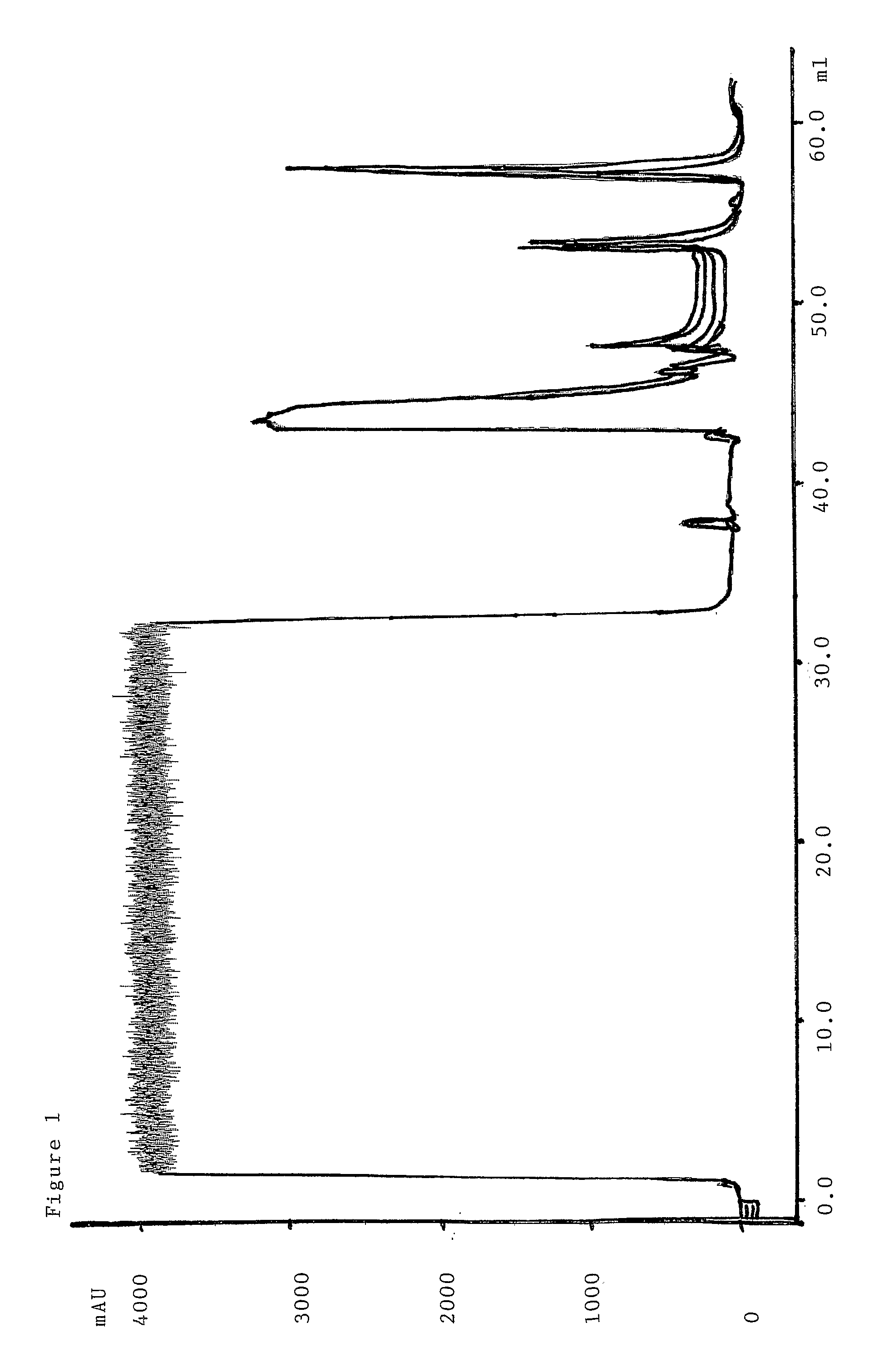Regeneration Of A Chromatography Matrix
- Summary
- Abstract
- Description
- Claims
- Application Information
AI Technical Summary
Benefits of technology
Problems solved by technology
Method used
Image
Examples
example 1
Column Packing
[0084] HR 5 / 5 column were filled with 4 M NaCl. A packing tube (HR 16) was connected, and was filled with 20% gel slurry in ˜0.2 M NaCl. Packing was then performed in Milli Q water at 3 ml / min for 3 min. The packing tube was then disconnected, and a top adaptor was lowered towards the gel surface. After additional packing at 3 ml / min, the adaptor was adjusted 1 mm into the bed. Packing was then continued at 1 ml / min for 20 minutes. Packing performance (i.e. plate number and asymmetry) was evaluated by injection of 100 μl 2% acetone at a flow rate of 0.35 mL / min. The acceptance criteria for the column packing were an asymmetry between 0.8-1.33 and number of theoretical plates >2000 N / m.
example 2
Purification Protocol According to the Invention
[0085] The method is summarised in table 1 below. The buffer compositions are found in section Materials / Investigated units above. The UV was detected at 280 nm.
TABLE 1A cleaning protocol according to the inventionStepAmountFlow (cm / h)BufferCommentEquilibration6CV300EquilibrationLoad15-18mg / ml*206CHO supernatant6 min residence time, load to 15-18 mg / mL mediaWash6CV300EquilibrationWash5CV30025 mM TRIS pH 8.0Elutionvaried300ElutionStart / stop collect at 300 mAUReducing reg6CV**300Reducing buffer100 mM 1-thioglycerol***Acid regener3CV206StripWash1CV206EquilibrationBasic regene3CV103CIP solution12 min residence timeWash0.5CV103Equilibration12 min residence time, performed every two cyclesStorage3CV103Storage12 min residence time, performed every two cycles
*The sample load was decreased to 15 mg / ml, i.e. 82% of QB,10%. In addition a control experiment was performed with human IgG in equilibration buffer as described below.
**A control exp...
example 3
Investigation of Eluate
Neutralisation of Eluate and Absorbance Measurement
[0086] The eluate was collected in test tubes to which 100 μl of neutralisation buffer had been added. The eluate was diluted (1:20) in equilibration buffer. The concentration of the sample solution was determined at 280 nm in a spectrophotometer and calculated according to Lambert Beer's law. The average value of the absorbance was used for concentration determination.
Protein A Leakage
[0087] Neutralized eluate was measured by ELISA as described in Steindl F and et al. A simple method to quantify staphylococcal protein A in the presence of human or animal IgG in various samples. J Immunol Meth (2000) 235, 61-9.
Frontal Analysis with Pure Fusion Protein
[0088] Frontal analysis was performed according to well known methods. The breakthrough capacity (QB10%) was calculated according to
QB10%=(V10%−Vo)Co / Vc
were V10%=applied sample volume at 10% breakthrough, Vo=void volume, Co=sample concentration (mg / ml)...
PUM
| Property | Measurement | Unit |
|---|---|---|
| Fraction | aaaaa | aaaaa |
| Fraction | aaaaa | aaaaa |
| Fraction | aaaaa | aaaaa |
Abstract
Description
Claims
Application Information
 Login to View More
Login to View More - R&D
- Intellectual Property
- Life Sciences
- Materials
- Tech Scout
- Unparalleled Data Quality
- Higher Quality Content
- 60% Fewer Hallucinations
Browse by: Latest US Patents, China's latest patents, Technical Efficacy Thesaurus, Application Domain, Technology Topic, Popular Technical Reports.
© 2025 PatSnap. All rights reserved.Legal|Privacy policy|Modern Slavery Act Transparency Statement|Sitemap|About US| Contact US: help@patsnap.com



